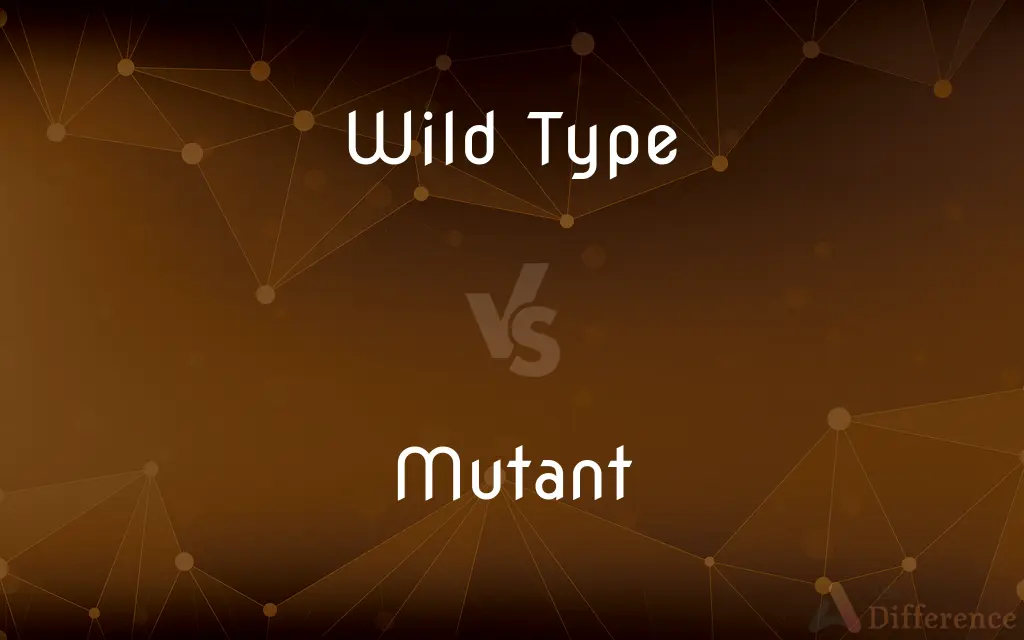Wild Type vs. Mutant — What's the Difference?
By Tayyaba Rehman — Published on December 27, 2023
Wild Type refers to the typical form of an organism or gene, while Mutant indicates a change or variation from this standard.

Difference Between Wild Type and Mutant
Table of Contents
ADVERTISEMENT
Key Differences
Wild Type represents the natural, non-mutated form of an organism or gene commonly observed in nature. In the context of genetics and biology, it is the reference standard against which mutations or changes are identified and compared. On the contrary, a Mutant arises when there's a change in the DNA sequence, leading to a variation from the Wild Type. This change can be due to various factors, including environmental influences or replication errors.
While the Wild Type is often associated with the "normal" or most common phenotype of a species, the Mutant can exhibit unique characteristics not found in the Wild Type.
Both the Wild Type and Mutant are crucial in scientific research, especially in understanding genetic variations, evolution, and potential adaptations of species.
The identification of the Wild Type aids in recognizing what's standard, whereas the Mutant offers insights into potential deviations and their implications.
Comparison Chart
Definition
Typical form of an organism or gene
Change or variation from the standard
ADVERTISEMENT
Origin
Naturally occurring form observed in nature
Arises due to changes in the DNA sequence
Associated Traits
Often represents the "normal" phenotype
Exhibits unique or altered characteristics
Occurrence in Population
Usually more common
Less common, varies based on the mutation's advantage/disadvantage
Role in Research
Serves as the reference standard
Offers insights into genetic variations and their implications
Compare with Definitions
Wild Type
The standard or typical form of an organism or gene.
The white flowers in the plant population are considered the Wild Type.
Mutant
An organism exhibiting characteristics not found in the Wild Type.
The Mutant plant displayed blue flowers instead of the usual white.
Wild Type
The naturally occurring form of a species as observed in nature.
Among the fruit flies, the red-eyed variant is the Wild Type.
Mutant
A result of environmental influences, replication errors, or other factors leading to genetic variation.
The Mutant fish had an extra fin, which wasn't observed in its native population.
Wild Type
The non-mutated form of an organism or gene.
In our genetic study, we used the Wild Type mice for comparison.
Mutant
An organism or gene that has undergone a change from the Wild Type.
The green-eyed variant of the fruit fly is a Mutant.
Wild Type
The phenotype most commonly observed in a natural population.
In certain bacteria, the Wild Type is resistant to specific antibiotics.
Mutant
A variation arising from a change in the DNA sequence.
The lab discovered a Mutant strain that exhibited faster growth rates.
Wild Type
The reference against which genetic mutations are identified.
Geneticists identified a mutation when the test organism deviated from the Wild Type.
Mutant
An alteration that deviates from the typical form of a species.
Scientists studied the Mutant bacteria to understand its increased resistance.
Wild Type
Alternative spelling of wild type
Mutant
An organism, cell, virus, or gene resulting from genetic mutation.
Mutant
(Slang) One that is suggestive of a genetic mutant, as in bizarre appearance or inaptitude.
Mutant
Resulting from genetic mutation
A mutant strain of bacteria.
Mutant
(Slang) Suggestive of a genetic mutant.
Mutant
(genetics) That has mutated, with one or more new characteristics from a mutation.
Mutant
(informal) Someone or something that seems strange, abnormal, or bizarre.
Your neighbor seems to be a mutant; he’s so cringy!
Mutant
(computing) mutex
Mutant
(genetics) Of, relating to, undergoing (i.e. mutating), or resulting from change or mutation; that has undergone mutation.
Mutant DNA
Mutant
(informal) Strange, abnormal, or bizarre.
Your mutant brother just growled at me again!
Mutant
(biology) an organism that has characteristics resulting from chromosomal alteration
Mutant
An animal that has undergone mutation
Mutant
Tending to undergo or resulting from mutation;
A mutant gene
Common Curiosities
What is the Wild Type?
The Wild Type is the standard or typical form of an organism or gene, commonly observed in nature.
Is the Wild Type always the most common form in nature?
Typically, yes. The Wild Type often represents the most common phenotype in a natural population.
Are all Mutants harmful or disadvantageous?
No, while some mutations can be harmful, others can be neutral or even beneficial, depending on the environment.
Are Mutants always visible or noticeable?
Not always. Some mutations can be silent or not produce observable changes in the organism's phenotype.
Can a Mutant become the Wild Type over time?
Yes, if a Mutant confers a significant advantage, it may become predominant and eventually be considered the Wild Type.
Does every mutation result in a new Mutant form?
Not every mutation results in a visible Mutant form; some mutations might be neutral or not alter the phenotype.
How is the Wild Type determined in research?
The Wild Type is determined by observing the naturally occurring, most common form of an organism or gene in a specific population.
Do all organisms have a clear Wild Type?
Generally, most organisms have a discernible Wild Type, but due to genetic diversity, some populations might have multiple common forms.
Can human activities create Mutants?
Yes, factors like radiation, chemicals, or genetic engineering can induce mutations.
What does Mutant mean?
A Mutant is an organism or gene that has undergone a change or variation from the Wild Type.
How is a Mutant created?
A Mutant can arise due to changes in the DNA sequence, environmental influences, replication errors, or other factors.
How do researchers use the Mutant in studies?
Researchers use Mutants to understand genetic variations, potential adaptations, and to study the effects of specific genes.
Is the Wild Type always the healthiest or fittest version of an organism?
Not necessarily. While the Wild Type is common, it may not always be the "fittest" in every environment.
Can Mutants revert to the Wild Type?
Yes, in some cases, reverse mutations can occur, leading the Mutant back to the Wild Type form.
Is the concept of Wild Type restricted only to animals?
No, the concept of Wild Type applies to all organisms, including plants, fungi, bacteria, and viruses.
Share Your Discovery

Previous Comparison
Komodo Dragon vs. Honey Badger
Next Comparison
Norton 360 Standard vs. Norton Antivirus PlusAuthor Spotlight
Written by
Tayyaba RehmanTayyaba Rehman is a distinguished writer, currently serving as a primary contributor to askdifference.com. As a researcher in semantics and etymology, Tayyaba's passion for the complexity of languages and their distinctions has found a perfect home on the platform. Tayyaba delves into the intricacies of language, distinguishing between commonly confused words and phrases, thereby providing clarity for readers worldwide.













































